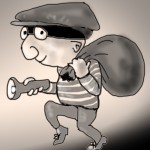We all use our senses, some of us differently or in more limited ways than others.
 The point of this post (and associated exercises) is to develop a more ‘writerly’ approach to sense-thinking. It’s about harvesting the information that is at your disposal in order to convey what isn’t. This can help make your settings and events as well as characters feel more ‘real’.
The point of this post (and associated exercises) is to develop a more ‘writerly’ approach to sense-thinking. It’s about harvesting the information that is at your disposal in order to convey what isn’t. This can help make your settings and events as well as characters feel more ‘real’.
I’ve said before that novel writing is 10% experience and 90% extrapolative invention. Of course, if you’ve lived through an earthquake, you probably don’t need to do much extrapolating.
But perhaps you were a bit too busy thinking of surviving to pay attention to details, or perhaps like me you were out of town when the earthquake hit.
So how do you write in-the-moment (that is, sensorily) about something you’ve never lived through?
– you can research — of course. Researching an event is an important way to gain insight. However often this is distant insight — useful for overview, but not so useful when writing from the perspective of a character in the moment being described.
– you can experience similar (presumably lesser) things and extrapolate.
Having only lived through my share of noteworthy events, I’m a big fan of extrapolation.
So what sorts of things am I talking about ‘extrapolating’ from?
If you’ve ever slid down crumbling scree or fallen off a moving object you have some experience with which to begin to imagine the earth shaking and ground moving. How about being on a train or bus that suddenly stopped?
If you’ve ever hit your knuckles hard, you’ve got some clue of what it might feel like to have one’s fingers chopped off or stomped on by a boot. That is, you don’t know how either of the latter feel, but you’ve some idea how it might.
If you’ve ever loved or been loved (requitedly or unrequitedly), you can imagine how to write anything from romance to adoring (or losing) a child.
A fight scene can be rendered more ‘real’ if you can remember and write how it felt to fall, take a knock, or lash out at something.
So how do you turn these remembered sensations into something bigger-picture or more gripping? In large part that’s the wordcraft business. To do this more effectively, look at my other posts on writing from the senses and metaphor.
Meanwhile, it can help to jot down a list of memorable experience you’ve had, and try to write at least 3 words or phrases that sum up the sensations or emotions involved. Be as glib as you like; for instance you might sum up the end of an affair like this:
shock — rejection — loss.
Those are three flat, unimaginative words, right? But now we can turn them into equivalent physical sensations to make them seem more graphic, so they might linger in the mind of the reader. Emotions can be described via physical movements as well as sensations.
For ‘shock’ you could think along the lines of how your body felt during a shocking moment: chilly; numb extremities; tingling; tight-lipped; dry-mouthed. Was there a lightning (hot or cold) flood through the limbs or a jabbing in the temples?
For ‘rejection’ you might describe sensations of shrinking or shrivelling; protective flinching; hot-headedness; dizziness; acridity in the mouth; bile or another bad taste. You might slouch; you might cringe; you might stare helplessly into space.
For ‘loss’, you might feel your clothes have become too big; you might grasp at things; you might feel hollow-stomached; you might continually look for something that isn’t there, or drop a hand onto the seat beside you frequently.
Whatever you describe, putting emotions into physical terms, if you can do so without resorting to cliché (‘pain in the heart’) will help them seem more ‘real’, while paying attention to how your senses work means you’re in a better state to write any situation realistically.
Just be careful if you decide to fall off a bicycle down a hill of scree for ‘research’.




